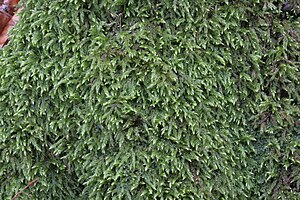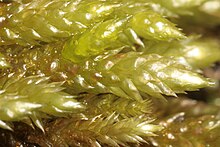Large mouse tail moss
| Large mouse tail moss | ||||||||||||
|---|---|---|---|---|---|---|---|---|---|---|---|---|

Great mouse- tailed moss ( Isothecium alopecuroides ) |
||||||||||||
| Systematics | ||||||||||||
|
||||||||||||
| Scientific name | ||||||||||||
| Isothecium alopecuroides | ||||||||||||
| ( Lam . Ex Dubois ) Isov. |
The large mouse -tailed moss ( Isothecium alopecuroides ), also known as large mouse-tailed moss or mouse-tailed-size moss , is a widespread species of deciduous moss . Synonyms are Isothecium myurum Brid. and Isothecium viviparum Lindb.
features
The strong plants grow in extensive green to dark green and slightly shiny covers. The arching ascending secondary stems arise from the creeping main stems. These are tufted at the top in branches that are curved downwards and have catkin-shaped leaves. The moist, upright, dry, roof-tiled leaves are 2 to 3 millimeters long, hollow, ovate, short-pointed, slightly toothed near the tip of the leaf, otherwise with entire margins. The leaf vein can be single or double and extends to the middle of the leaf or a little above it.
The leaf cells are linear-worm-shaped in the middle of the leaves, up to 10 times as long as they are wide, shorter at the leaf tip and rectangular at the leaf base. The brown auricles have opaque, thick-walled, square cells that are clearly separated from the other leaf cells.
Sporophytes are not infrequently formed. They have an approximately 1 to 1.5 centimeter long, reddish, smooth seta and an upright, elliptical to short cylindrical capsule with a short beaked lid. Spores are yellow-green, granular and about 12 to 16 µm in size. Spore ripening is in autumn and winter. The plants are dioecious .
Distribution and location requirements
The greater mouse-tailed moss occurs in Europe, parts of Asia, North Africa, the Canary Islands and North America. It is widespread and often common in Central Europe, especially in the low mountain ranges and the Alps.
It grows in forests at the base of deciduous trees and on base-rich, weakly acidic rock, less often on earth.
literature
- Jan-Peter Frahm , Wolfgang Frey : Moosflora (= UTB . 1250). 4th, revised and expanded edition. Ulmer, Stuttgart 2004, ISBN 3-8252-1250-5 .
- Martin Nebel, Georg Philippi (ed.): The mosses of Baden-Württemberg. Volume 2: Special part, (Bryophytina II, Schistostegales to Hypnobryales). Ulmer, Stuttgart 2001, ISBN 3-8001-3530-2 .
- Ruprecht Düll , Barbara Düll-Wunder: Determine mosses easily and reliably. An illustrated excursion guide to the types of Germany and neighboring countries. Quelle & Meyer, Wiebelsheim 2008, ISBN 978-3-494-01427-2 .

